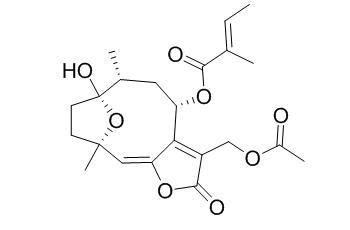8alpha-Tigloyloxyhirsutinolide 13-O-acetate
8alpha-Tigloyloxyhirsutinolide 13-O-acetate shows inhibitory activity toward CYP2A6 and MAO-A and MAO-B enzymes. 8alpha-Tigloyloxyhirsutinolide 13-O-acetate has anti-cancer activity, it is active against both cancer cell lines (IC50 = 3.50 microM for HT29 and IC50 = 4.27 microM for HepG2).
Inquire / Order:
manager@chemfaces.com
Technical Inquiries:
service@chemfaces.com
Tel:
+86-27-84237783
Fax:
+86-27-84254680
Address:
1 Building, No. 83, CheCheng Rd., Wuhan Economic and Technological Development Zone, Wuhan, Hubei 430056, PRC
Providing storage is as stated on the product vial and the vial is kept tightly sealed, the product can be stored for up to
24 months(2-8C).
Wherever possible, you should prepare and use solutions on the same day. However, if you need to make up stock solutions in advance, we recommend that you store the solution as aliquots in tightly sealed vials at -20C. Generally, these will be useable for up to two weeks. Before use, and prior to opening the vial we recommend that you allow your product to equilibrate to room temperature for at least 1 hour.
Need more advice on solubility, usage and handling? Please email to: service@chemfaces.com
The packaging of the product may have turned upside down during transportation, resulting in the natural compounds adhering to the neck or cap of the vial. take the vial out of its packaging and gently shake to let the compounds fall to the bottom of the vial. for liquid products, centrifuge at 200-500 RPM to gather the liquid at the bottom of the vial. try to avoid loss or contamination during handling.
Int J Mol Sci.2024, 25(12):6456.
J Pharm Biomed Anal.2024, 247:116257.
Nutrients.2023, 15(12):2810.
J Appl Microbiol.2022, 132(2):949-963.
J Appl Biol Chem.2024, V67:46-53
Natural Product Communications2023, 18(9).
Universiti Tunku Aboul Rahman2023, 6263.
Int J Immunopathol Pharmacol.2019, 33:2058738419857537
Curr Res Food Sci.2024, 9:100827.
Applied Biological Chemistry 2022, 65,5(2022).
Related and Featured Products
Drug Metab Pharmacokinet. 2015 Apr;30(2):174-81.
Inhibition effects of Vernonia cinerea active compounds against cytochrome P450 2A6 and human monoamine oxidases, possible targets for reduction of tobacco dependence.[Pubmed:
25857233 ]
The human cytochrome P450 2A6 (CYP2A6) and monoamine oxidases (MAO-A and MAO-B), catalyzing nicotine and dopamine metabolisms, respectively, are two therapeutic targets of nicotine dependence. Vernonia cinerea, a medicinal plant commonly used for treatment of diseases such as asthma and bronchitis, has been shown reducing tobacco dependence effect among tobacco users.
METHODS AND RESULTS:
In the present study, we found eight active compounds isolated from V. cinerea that comprise inhibitory activity toward CYP2A6 and MAO-A and MAO-B enzymes using activity-guided assays, with coumarin as substrate of CYP2A6 and kynuramine of MAOs. These compounds were three flavones (apigenin, chrysoeriol, luteolin), one flavonol (quercetin), and four hirsutinolide-type sesquiterpene lactones 8alpha-(2-Methylacryloyloxy)hirsutinolide 13-O-acetate, 8α-(4-hydroxymethacryloyloxy)-hirsutinolide-13-O-acetate, 8alpha-Tigloyloxyhirsutinolide 13-O-acetate, and 8α-(4-hydroxytigloyloxy)-hirsutinolide-13-O-acetate). Modes and kinetics of inhibition against the three enzymes were determined. Flavonoids possessed strong inhibitory effect on CYP2A6 in reversible mode, while inhibition by hirsutinolides was mechanism-based (NADPH-, concentration-, and time-dependence) and irreversible. Inhibition by hirsutinolides could not be reversed by dialysis and by addition of trapping agents or potassium ferricyanide.
CONCLUSIONS:
Flavonoids inhibited MAOs with variable degrees and were more prominent in inhibition toward MAO-A than hirsutinolides, while two of hirsutinolides inhibited MAO-B approximately comparable to two flavonoids. These results could have implications in combination of drug therapy for smoking cessation.
Nat Prod Commun. 2012 Oct;7(10):1259-62.
HPLC analysis and cytotoxic activity of Vernonia cinerea.[Pubmed:
23156983]
METHODS AND RESULTS:
The extracts of five Cambodian medicinal plants (Aganosma marginata, Dracaena cambodiana, Harrisonia perforata, Hymenodictyon excelsum and Vernonia cinerea) were evaluated in vitro for their cytotoxic activity against HT29 colon adenocarcinoma cells and HepG2 hepatoma cells, using the MTT assay.
METHODS AND RESULTS:
Among these five plants, Vernonia cinerea displayed potent cytotoxicity. One main sesquiterpene lactone, 8alpha-Tigloyloxyhirsutinolide 13-O-acetate was isolated from the whole plant of V. cinerea.
CONCLUSIONS:
This compound was active against both cancer cell lines (IC50 = 3.50 microM for HT29 and IC50 = 4.27 microM for HepG2). To quantify this compound in the plant, an analytical high-performance liquid chromatography (HPLC) method was developed and validated.



